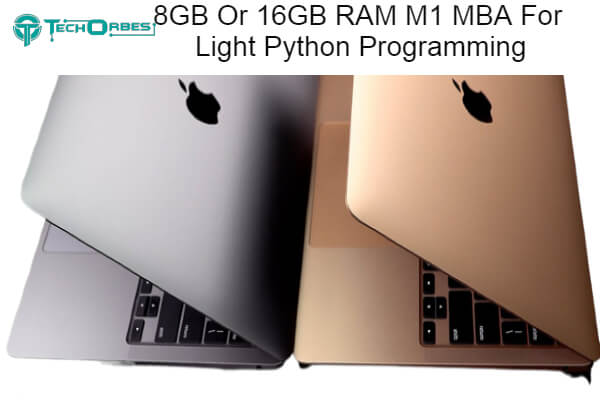8GB Or 16GB RAM M1 MBA For Light Python Programming (Answer)
The original M1 is a reasonably powerful computer on its own and is incredibly memory efficient. Is 8GB Or 16GB RAM M1 MBA For Light Python Programming? In your situation, 8GB should be sufficient, but 16 GB is better.
8GB Or 16GB RAM M1 MBA For Light Python Programming
It appeared unexpected that the entry-level MacBook Pro with an M1 processor only had 8GB of RAM when Apple unveiled it in 2020. 8GB of memory felt too little for a machine with the word “Pro” in the name. As of this writing, Apple is still selling the 2020 13-inch MacBook Pro, and 8GB of RAM is still the default setting. Does Apple undoubtedly believe that 8 megabytes is sufficient, but is it?

Does a MacBook Pro need more than 8GB of RAM? The quick response is that 95% of consumers won’t need more RAM than the MacBook Pro’s 8 GB. But before you immediately decide to get that MacBook, let’s take a deeper look at the specifics so you can choose which choice is ideal for you.
Should You Get 8GB Or 16GB Of RAM In Your Macbook Pro?
Max Tech’s side-by-side testing of 8GB and 16GB M1 Macbook Pros revealed that the 16GB model ran RAM-demanding applications like Adobe Lightroom and XCode roughly 10% faster. The 16GB MacBook Pro 2020 completed the 8K footage export test in less than half the time it took the 8GB model to complete the same test (14 minutes vs. 6 minutes).
The question’s solution ultimately depends on how you intend to use your MacBook Pro. 16 GB may be helpful if you intend to render videos or compile programs. For the majority of people, 8GB will do.
8GB Of RAM Is Probably Insufficient, But You May Never Notice
Although it might seem counterintuitive, your Mac needs more RAM than the 8GB it now has. I’ll explain. Virtual memory is a tool used by computers to control RAM utilization. The operating system produces a page file, commonly called a swap file, by removing space from the hard drive. If your computer’s real RAM runs out, it can use this file, which acts as virtual RAM, for more memory.
To free up RAM, the computer offloads programs and tasks that aren’t in use to the hard disk. The operating system will then “swap” the processes with other items to move the necessary application back into memory when a user needs to run an offloaded program.
Switching between apps would take a long time when hard drives were mechanical, slowing down your computer. The influence of the swap file is reduced by the significantly quicker solid-state hard drives (also known as SSDs) that are common in modern computers. However, physical RAM continues to outperform SSDs in speed. However, Apple appears to have significantly improved the swap process, making it hardly visible.
However, because Apple’s SSDs and SoC are so effective at producing and using virtual memory, you probably won’t even realize when you run out of RAM. Currently, medium to heavy users will quickly use up 8GB of RAM. Because of this effectiveness, there are worries that the SSD will deteriorate because it is used more frequently to act as virtual RAM.
These worries, in my opinion, are exaggerated because SSD technology is getting stronger every year, but there’s no disputing that macOS is pretty demanding on the hard disk. Why? since it is capable. If you have serious concerns about this, get 16GB of RAM.
However, remember that your Mac will continue to use the SSD for swap, and you have no influence over how the system operates. With 16GB of actual RAM, you should theoretically require less virtual RAM.
Is M1 Suitable For Developers?
There are several different Mac models available if you’re a programmer. Which is best for you will be based on the type of coding you’re doing. Integrated graphics might be unable to keep up with graphically demanding apps requiring a sound graphics card. You’ll probably need a strong processor, lots of RAM, and sufficient storage for all your efforts. But is pure power the only thing that counts? Find out by reading our article on the best Macs for developers.
Why Choose A Mac While Developing Apps?
Apple Macs have progressively favored among developers in recent years, even though many developers still use Windows PCs. The Unix command line is at least partially to blame for this. The Unix-based macOS is a logical choice because it is the foundation for most servers and file systems. macOS is cross-platform compatible, so you can quickly run both Linux and Windows. Additionally, any Mac’s architecture is stunning.
Picking Out The Ideal Mac For Coding
RAM is arguably the most crucial component in coding. When you mix Xcode with other apps, which are already quite RAM-intensive, you’ll quickly discover that you need a lot of RAM to keep everything functioning correctly.
To release RAM, you might even need to terminate processes manually. 8GB of RAM is the minimum for a pleasurable coding experience. To build a safety net for upcoming updates, you should ideally consider 16GB or more. Notably, the newer M1 Macs have a RAM limit of 16GB, but since they manage RAM differently than Intel Macs, that’s more than enough.
A big screen is also helpful. You’ll probably have at least three windows open at once. You need a large monitor to fit them all on one screen and eliminate the need to switch between them. External monitors can always be plugged in, so even a smaller MacBook would be adequate.
The M1 Macs only handle up to two displays at once, so if you frequently use multiple monitors, you should be aware of this. This means that iMacs and MacBooks can use one external display, whereas Mac minis can use two. Although there are workarounds for this, it is not natively supported.
You’ll need a processor that is at least passable, although any of the Macs that are currently on the market will do. However, a Mac Pro with its 28-core beast is unnecessary because it would be excessive. You don’t need a lot of storage for programming, although we advise using a solid-state drive over a hard disk. Working with apps and files will go considerably more quickly as a result.
Lastly, confirm that the Mac you choose has enough ports for everything you require. You may require adapters and hubs for programming if your modern Mac only has a few USB-C connections.
16-Inch MacBook Pro The Finest Mac Overall For Development
Although Apple desktop computers are excellent for programming, a MacBook’s versatility is difficult to match. While the 13-inch Intel and M1 Macbooks are both powerful enough, we would prefer something a little larger for our extended coding sessions.
Therefore, the 2019 16-inch MacBook Pro is ideal. In 2019 this model, which has substantially higher specs, took the place of the 15-inch Mac. A six-core i7 processor running at 2.6GHz, 16GB of RAM, and a 512GB SSD are included in the base specification. However, you can significantly increase these specifications, bringing the cost from $2,399 to over $6,000.
The 16-inch MacBook is inevitably heavier due to its extreme size. It weighs 4.3 pounds, which is not at all light. It also gives you a larger keyboard, which is great for programming, and a fabulous giant screen.
You can connect up to two displays with a resolution of 6016×3384 as external displays. Alternatively, you might link up to four 4096×2304 screens. Additionally, the MacBook includes a built-in display, giving you many options.
So Is The Base Macbook Air Powerful Enough?
I believe the obvious answer is that the base models of these computers with 8GB of RAM will be sufficient for the vast majority of users, even for those who err on the “professional” side of DJ laptop multitasking with several apps, a dozen browser tabs, and multiple types of media playing at the same time.
They are sufficient, but encouraging them to slow down is also very challenging. Perhaps if you multitask a lot with the Adobe suite, you’ll find yourself in a situation where you could be tempted to future-proof your device. However, even in that case, the following ARM versions of those applications should run smoothly on these devices.
The point is that I haven’t attempted running a live DJ setup on this machine or utilizing it to do intensive video editing in Final Cut Pro or GarageBand. The idea is that a MacBook Air is typically used for web browsing, light work, and other activities. As shocking as it may sound, the base model MacBook Air is powerful enough that most people probably won’t find it worthwhile to spend an additional $200 to upgrade to 16GB of RAM.
To Conclude
Did you decide on 8GB Or 16GB RAM M1 MBA For Light Python Programming? The M1 is a powerful and memory-efficient computer. 8GB is enough, but 16GB is preferable. Although the vast majority of people only need 8GB, there are still some situations where choosing 16GB of RAM makes sense.
Your upgrade cycle is one thing to think about. Do you switch up your MacBook Pro every two years or wait until it’s no longer functional? If the latter, 16GB could be valid. If you intend to sell the MacBook in the future, consider the resale value. Future worth is difficult to forecast, but a Mac with twice as much RAM will sell for more.
Frequently Asked Questions
The MacBook Air is it suitable for programming?
The MacBook Air is frequently suitable for programming. It is lightweight and powerful enough to be carried around wherever for impromptu coding sessions for medium-level apps.
Which Mac model is ideal for software development?
The 16-inch MacBook Pro is the ideal Mac for developing software (2019). It has a six-core i7 processor running at 2.6GHz, 16GB of RAM, and up to 1TB of storage. Think about the 2020 MacBook Pro, which has a powerful M1 chip inside and a battery ideal for extended coding sessions if you don’t mind a smaller screen.
Is a Core i5 powerful enough to program?
You may wish to spend money on a Core i7 processor or choose a less expensive Core i5 processor, depending on the type of coding you do. For instance, an i5 will work perfectly for a front-end web developer who primarily uses a text editor and a browser.
Is 4GB RAM sufficient for coding?
In general, 4GB RAM is insufficient for most programming activities today. You’ll need at least 8GB to run Xcode alone, assuming you don’t take on any particularly demanding tasks.
Consider purchasing 16GB or more for more complicated tasks requiring more tools. However, since they manage memory differently, M1 Macs only give 16GB, which is more than plenty.
Does coding require a powerful computer?
You don’t even need a robust system to be a programmer. It will do with an M1 chip or a quad-core i5 processor with 8GB RAM and 256GB SSD memory. In terms of screen size and resolution, ensure your display is large enough to accommodate all of your apps. Or consider a Mac with enough external monitor support.

Rayssa is a native American. A group of specialized individuals raised her with a passion for gaming. Here she discovered that computer games can expand your creative mind to infinite possibilities. In recent years, she has gone beyond gaming as a means of entertainment to enjoy it as a passio
